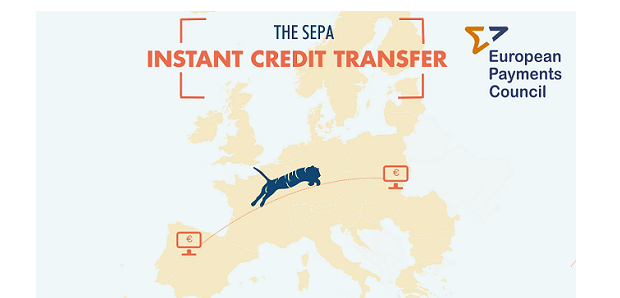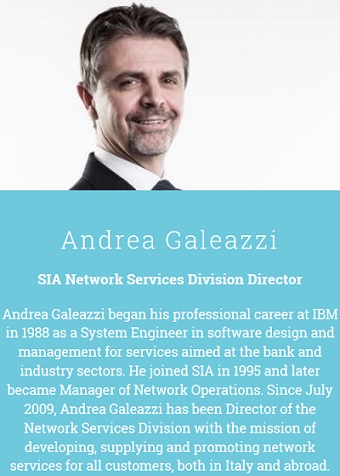
 The European Payments Council’s SEPA Instant Credit Transfer scheme (SCT Inst) was created in close collaboration with stakeholders from across the payment chain and officially launched in November 2017. Since then, 1,043 European payment service providers (PSPs) have joined the scheme.
The European Payments Council’s SEPA Instant Credit Transfer scheme (SCT Inst) was created in close collaboration with stakeholders from across the payment chain and officially launched in November 2017. Since then, 1,043 European payment service providers (PSPs) have joined the scheme.
Andrea Galeazzi, Network Services Director at SIA, has been supporting PSPs in their SCT Inst implementation. He describes the early adopters of the scheme.
First, could you explain how SIA is already supporting PSPs in their SCT Inst?
SIA launched a new digital platform to enable banks and other PSPs to manage instant payments at the European level in addition to all other SEPA instruments. SIA Easyway operates as a ‘hub’, simplifying the integration of instant payments with the financial institutions’ internal systems, reducing costs and activation times for new services. Value-added services are also available, including fraud monitoring and prevention, identification of suspicious transactions and the innovative ‘mirror account’, which makes instant payments possible 24/7/365.
This platform allows PSPs to onboard in a very short time using smart, simplified services and web interfaces to connect initiating channels to RT1 (EBA Clearing’s instant payment processing platform). Through the SIAnet fibre-optic network, which guarantees secure and ultra-fast connections thanks to a new low-latency messaging technology, SIA EasyWay is natively integrated with RT1 but can also connect to the European Central Bank’s (ECB) forthcoming TARGET instant payment settlement service (TIPS) and any other European automated clearing houses.
To meet all the strict requirements of the SCT Inst scheme, a new SIAnet connectivity service is available to the European financial community through a fast, safe and strong protocol specifically designed to handle instant payments. This service is able to exchange transactions between the sender and the receiver in under 200 milliseconds. SIAnet for instant payment has already been adopted in Italy and in Europe, reaching all SCT Inst participants (commercial banks, central banks and technical facilitators).
Which aspects of the SCT Inst scheme implementation concern the PSPs with whom you work?
Similar concerns came up during meetings with PSP willing to join the SCT Inst scheme. They required the fastest delivery possible, including guaranteed delivery performances in terms of latency, potentially with service level agreement commitment. PSPs understood they must be available 24/7/365, running their applications on multiple active sites and over reliable links.
Security also presents concerns: PSPs fear the risk involved in real-time transactions that allow the beneficiary to use funds immediately. That’s why they asked us to strengthen the authorisation and authentication on the bank site perimeter, and to protect them from message tampering and spoofing attacks that might also come from the bank’s internal infrastructure.
Furthermore, PSPs security managers requested the best security measures and technologies, using security protocols and secure storing of private keys on Hardware Security Modules (HSMs). Another relevant topic is the 24/7/365 availability of accounts and all other core-banking modules involved in handling SCT Inst, since few banks are currently able to offer this feature.
What opportunities do you anticipate them discovering thanks to the SCT Inst scheme?
In the near future, the adoption of the SCT Inst scheme will become a survival choice for PSPs responding to evolving customer demand and competition from non-banking players. For the time being, different approaches have been adopted, depending on PSPs’ risk appetite. Some want to join the new scheme soon; others are waiting for the community to grow in terms of participants’ reachability. As soon as this community broadens, a gradual switchover of traditional initiating channels and processes from the batch/bulk credit transfer option is expected. In addition, the SCT Inst is also going to expand to transactions now covered by instruments other than the credit transfer.
We also see opportunities for cost reduction if PSPs’ internal processes such as treasury operations, cash management, corporate banking financial flows, etc. are streamlined.
Did you encounter any hurdles in the implementation of your SCT messaging network service?
The biggest obstacle in the adoption of the SCT Inst scheme was time. Most of the players we met who were willing to be early adopters had to deal with the time constraint. It was probably linked to the idea that an instant payment would simply be a faster SCT.
Regarding the network services, the adoption of the SCT Inst scheme requires a complete reset of banks’ connectivity habits. An instant payment message must be delivered in milliseconds, and the receiver must always be online to handle it.
Finally, how do you see the scheme evolving in the near future?
The revised Payment Services Directive is a great driver behind the SCT Inst scheme. Many players can use the new payment workflows. The beneficiary is now able to initiate and execute payments authorised by the payer, reducing the actual time lag between a card payment and a credit transfer.
A significant push to develop new features could come from the adoption of the new scheme in the Corporate to Bank (C2B) environment, switching massive payment orders to instant SCT and overcoming the current threshold of 15,000 euros.
Source: European Payments Council
Banking 4.0 – „how was the experience for you”
„To be honest I think that Sinaia, your conference, is much better then Davos.”
Many more interesting quotes in the video below: